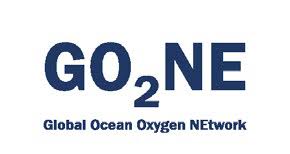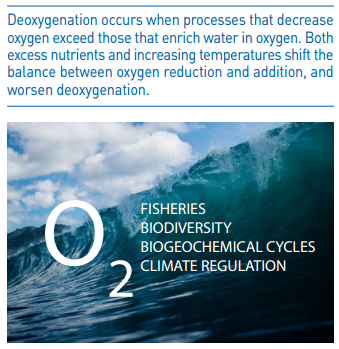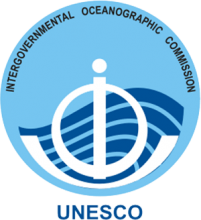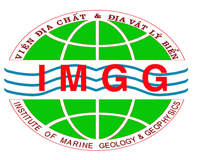Deoxygenation – Open Ocean and Coastal Waters
Oxygen is critical to the health of the planet. It affects the cycles of carbon, nitrogen and other key elements, and is a fundamental requirement for marine life from the seashore to the greatest depths of the ocean. Nevertheless, deoxygenation is worsening in the coastal and open ocean. This is mainly the result of human activities that are increasing global temperatures (CO2-induced warming) and increasing loads of nutrients from agriculture, sewage, and industrial waste, including pollution from power generation from fossil fuels and biomass.
Global Ocean Oxygen Network
Through the participation of high level scientists from across the world, the IOC expert group, the Global Ocean Oxygen Network GO2NE, established in 2016, is committed to providing a global and multidisciplinary view of deoxygenation, with a focus on understanding its multiple aspects and impacts. The Network offers scientific advice to policy makers to counter this concerning trend and to preserve marine resources in the presence of deoxygenation. Currently, the members of the core working group represent 21 institutions in 11 countries.

The Network’s scientific work, outreach, and capacity building efforts include facilitating communication with other established networks and working groups (e.g. IOCCP, GOOS, IGMETS, GOA-ON, GlobalHAB, WESTPAC O2NE), improving observations systems, identifying and filling knowledge gaps, as well as developing related capacity development activities. GO2NE is moreover preparing a summary on deoxygenation for policy makers.

In collaboration with SFB754, it recently initiated the news site ocean-oxygen.org to provide information on deoxygenation to scientists, stakeholders and the interested public.
A wide range of actions are planned for the upcoming years to raise awareness, to encourage international collaboration, to create knowledge on current and future impacts of declining oxygen concentrations in the ocean on marine organisms, ecosystems, biogeochemical cycles and human well-being.
In this context, the Global Ocean Oxygen Network established by the Intergovernmental Oceanographic Commission of UNESCO, is committed to broaden the understanding and support underlying science regarding the impacts of nutrient pollution on increased deoxygenation (SDG 14.1). It further supports the implementation of sustainable fisheries (SDG 14.7), and aims to improve the knowledge of how reduced oxygen levels are linked to additional stressors, such as harmful algal blooms, ocean acidification and global warming, that combine to reduce marine ecosystem resilience and ecosystem services (SDG 14.3).
This voluntary commitment clearly aims to increase scientific knowledge, develop research capacity and transfer marine technology, taking into account the Intergovernmental Oceanographic Commission Criteria and Guidelines on the Transfer of Marine Technology (SDG 14.a).
This commitment intends to support ocean health and to enhance the contribution of marine biodiversity to the development of sustainable use of marine resources, which are endangered by more than 500 coastal ecosystems identified as suffering from hypoxia and a loss of more than 2% (77 billion tons) of the global ocean oxygen inventory since 1960.
There are 10 main ocean oxygen concerns:
1. Increasing temperatures will reduce the capacity of the ocean to hold oxygen in the future;
2. Oxygen deficiency is predicted to worsen in estuaries, coastal areas and oxygen minimum zones in the open ocean;
3. The ocean’s capacity to produce oxygen will be reduced in the future.
4. Habitat loss is expected to worsen, leading to vertical and horizontal migration of species;
5. Oxygen deficiency will alter biogeochemical cycles and food webs;
6. Lower oxygen concentrations are projected to result in a decrease in reproductive capacity and biodiversity loss;
7. There are important local decreases of commercially important species and aquaculture production;
8. Harmful Algal Blooms might benefit from nutrients released in bottom waters due to hypoxia (e.g. in the Baltic Sea);
9. Reduced ocean oxygen concentrations will lead to an increase in greenhouse gas emissions, thereby initiating feedbacks on climate change;
10. Future scenarios for oxygen depend on a combination of drivers related to global environmental change and land-use, including warming, growing human population, and extensive coastal agricultural practices, which, in turn, act together in affecting marine ecosystems – thus, a multi-stressor approach is important.

In 2018, a book titled “The Ocean is Losing its Breath: Declining Oxygen in the World’s Ocean and Coastal Waters” was prepared by a group of concerned scientists from across the world, the IOC expert group, the Global Ocean Oxygen Network GO 2NE, established in 2016, which is committed to providing a global and ultidisciplinary view on deoxygenation, with a focus on understanding its various aspects and impacts.
The document presents a summary of scientific experiments, observations and numerical models addressing the following questions: How has the oxygen content in the open ocean and coastal waters changed over the past century and through geological time? What are the mechanisms behind this oxygen decline? How is ocean oxygen content predicted to change over the rest of the twenty-fist century? What are the consequences of low and declining oxygen concentrations in the marine environment?
The full book could be downloaded here.
http://unesdoc.unesco.org/images/0026/002651/265196e.pdf
(Source: IOC/UNESCO)












